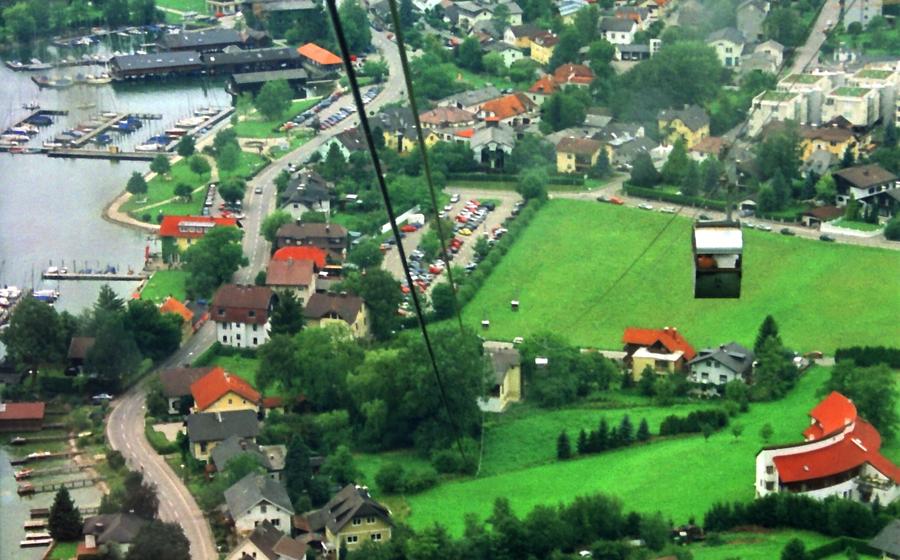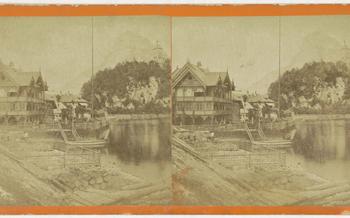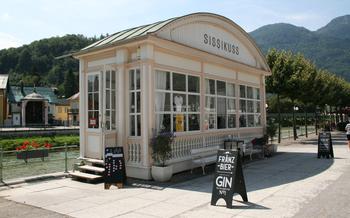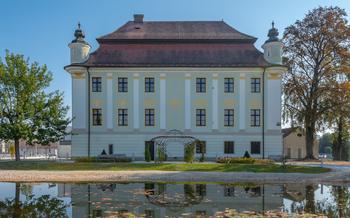
Ebensee Concentration Camp Memorial
- The Ebensee Concentration Camp Memorial: A Sobering Reminder of Austria's Dark Past
- The Memorial Site: Preserving the Memory
- The Barracks: A Tangible Reminder of Suffering
- The Watchtowers: Symbols of Oppression
- The Crematorium: A Place of Horror and Loss
- The Mass Graves: Silent Witnesses to Atrocities
- The Dokumentationsarchiv: Preserving the Historical Record
- The Commemorative Events: Honoring the Victims
- Visitor Information: Planning Your Visit
- Transportation: Getting to the Ebensee Concentration Camp Memorial
- Nearby Attractions: Exploring the Region
- Accommodation: Finding a Place to Stay
- Insider Tip: A Deeper Dive into Ebensee's History
The Ebensee Concentration Camp Memorial: A Sobering Reminder of Austria's Dark Past
In the heart of Austria's scenic Salzkammergut region lies a poignant reminder of one of the darkest chapters in human history: the Ebensee Concentration Camp Memorial. Established in 1943 as a subcamp of the infamous Mauthausen concentration camp, Ebensee served as a place of unspeakable suffering and loss for thousands of prisoners during World War II. Today, the meticulously preserved memorial site stands as a testament to the resilience of the human spirit and the enduring legacy of those who perished within its walls. Visitors to Ebensee are invited to embark on a journey of remembrance and reflection, confronting the horrors of the past while honoring the memory of those who lost their lives.
Location and Accessibility: Situated in the picturesque town of Ebensee, the memorial site is easily accessible by car or public transportation. Guided tours are available to provide visitors with a comprehensive understanding of the camp's history, its role within the Nazi concentration camp system, and the harrowing experiences endured by its prisoners.
What to Expect During a Visit: A visit to the Ebensee Concentration Camp Memorial is a deeply moving and profoundly educational experience. Visitors will encounter meticulously preserved barracks, watchtowers, and the crematorium, each bearing witness to the atrocities that took place within the camp's confines. The memorial site also features a comprehensive documentation center, showcasing artifacts, documents, and personal accounts that shed light on the camp's history and the lives of its prisoners.
The Memorial Site: Preserving the Memory
In 1995, the Ebensee Concentration Camp Memorial was established as a permanent site of remembrance and education. Designed by architect Hans Peter Wörndl, the memorial site is comprised of several structures and features that poignantly convey the history and significance of the camp.
The layout of the memorial site is intentionally simple, allowing visitors to focus on the stories and experiences of those who suffered here. The main entrance leads to a central plaza, where a large granite monument commemorates the victims of the camp. The monument bears the names of over 40,000 prisoners who perished in Ebensee, a powerful reminder of the scale of human loss.
Surrounding the plaza are a series of buildings and exhibits that provide visitors with a deeper understanding of the camp's history and operation. The documentation center houses archives, photographs, and personal accounts that chronicle the daily life of prisoners, the atrocities committed by the SS, and the eventual liberation of the camp.
Interactive displays and multimedia presentations help bring the past to life, offering visitors a glimpse into the lives of the prisoners and their struggle for survival. The memorial site also includes a room dedicated to the memory of the children who were imprisoned and killed in Ebensee, a particularly heart-wrenching reminder of the camp's cruelty.
The Barracks: A Tangible Reminder of Suffering
Within the confines of the Ebensee concentration camp, the barracks stand as grim testaments to the horrors inflicted upon the prisoners. These dilapidated structures, once housing hundreds of inmates in cramped and inhumane conditions, evoke a profound sense of suffering and despair.
Constructed hastily from wood and other rudimentary materials, the barracks provided little protection from the harsh elements. Prisoners were forced to endure freezing temperatures in winter and sweltering heat in summer, as well as the constant threat of disease and infection.
The interior of the barracks was a scene of utter destitution. Triple-decker bunks, often infested with lice and other vermin, served as the only sleeping quarters for the prisoners. Personal space was nonexistent, and the air was thick with the stench of sweat, urine, and human waste.
Overcrowding was rampant, with up to 1,000 prisoners crammed into a single barrack. This overcrowding led to unsanitary conditions, rampant disease, and the spread of deadly epidemics. Many prisoners succumbed to illness or died from exhaustion and malnutrition.
The barracks at Ebensee Concentration Camp stand as a tangible reminder of the systematic dehumanization and suffering endured by the prisoners. These structures serve as a chilling testament to the atrocities committed during this dark chapter in human history.
The Watchtowers: Symbols of Oppression
Strategically positioned at the corners of the camp, the watchtowers served as constant reminders of the inmates' captivity and the omnipresent threat of surveillance. These elevated structures provided the guards with a clear view of the entire compound, allowing them to maintain control and prevent escape attempts. From their vantage point, the guards could observe the prisoners' every move, creating an atmosphere of fear and intimidation. The watchtowers became symbols of the oppressive regime, as they represented the power and authority of the Nazis over the defenseless inmates.
The Crematorium: A Place of Horror and Loss
The crematorium at the Ebensee Concentration Camp stands as a grim reminder of the horrors inflicted upon the prisoners. Built in 1943, it became the central facility for the disposal of bodies from the camp and its subcamps. The process of cremation was systematic and dehumanizing. Prisoners' bodies were transported to the crematorium on carts or in trucks, stripped of their personal belongings, and then incinerated in the ovens. The ashes were collected and often scattered in nearby fields or dumped into the nearby Traun River.
The crematorium served not only as a means of disposing of the dead but also as a tool of terror and intimidation. The sight and smell of burning flesh filled the air, a constant reminder of the prisoners' fate. The crematorium's location, situated on a hill overlooking the camp, ensured that its presence was inescapable. It became a symbol of the camp's brutality and the Nazis' utter disregard for human life.
The Mass Graves: Silent Witnesses to Atrocities
Within the grounds of the Ebensee Concentration Camp Memorial lie several mass graves, serving as a poignant reminder of the horrors that unfolded here. These unmarked graves, scattered across the site, bear silent witness to the countless individuals who lost their lives during the camp's operation.
The mass graves were discovered after the liberation of the camp, when the true extent of the atrocities committed became known. Exhumations were conducted, and the remains of over 20,000 victims were recovered and identified. These individuals, hailing from various countries and backgrounds, had been subjected to unimaginable suffering and ultimately met their tragic end within the confines of Ebensee.
Today, the mass graves stand as a powerful symbol of the loss and suffering endured by the prisoners. Visitors to the memorial site can pay their respects and remember the victims by visiting these solemn resting places. The graves serve as a stark reminder of the human cost of war and oppression, and underscore the importance of preserving the memory of those who perished here.
The Dokumentationsarchiv: Preserving the Historical Record
The Dokumentationsarchiv is a crucial component of the Ebensee Concentration Camp Memorial, dedicated to preserving and documenting the historical record of the camp. This extensive archive houses a vast collection of documents, artifacts, and personal accounts related to the camp's operation and the experiences of its prisoners.
The archive's collection includes official Nazi documents, inmate records, photographs, maps, and other materials that shed light on the camp's administration, daily life, and atrocities committed within its walls. Personal diaries, letters, and testimonies from survivors provide firsthand accounts of the suffering and resilience of the prisoners.
The Dokumentationsarchiv serves as a valuable resource for researchers, historians, and anyone interested in gaining a deeper understanding of the Ebensee Concentration Camp and the broader history of the Nazi regime. Its collection contributes to the preservation of memory, facilitates historical research, and promotes education about the Holocaust.
Visitors to the Ebensee Concentration Camp Memorial are encouraged to explore the Dokumentationsarchiv to learn more about the camp's history and the individual stories of those who were imprisoned there. Through its extensive collection and ongoing research, the archive plays a vital role in keeping the memory of the victims alive and ensuring that the lessons of the past are never forgotten.
The Commemorative Events: Honoring the Victims
To honor the memory of those who suffered and perished in Ebensee Concentration Camp, the memorial site holds annual commemorative events and ceremonies. These solemn occasions bring together survivors, their families, members of the local community, and visitors from around the world to pay tribute to the victims and reflect on the atrocities committed during the Nazi regime.
The most prominent event is the annual liberation ceremony, held on the anniversary of the camp's liberation by American forces in May 194During this ceremony, wreaths are laid at the memorial site, and speeches are given by survivors, government officials, and representatives of various organizations. The names of the deceased are read aloud, and a moment of silence is observed to honor their memory.
Other commemorative events include exhibitions, lectures, and workshops that delve deeper into the history of the camp and its impact on the region. These events provide a platform for education, remembrance, and reconciliation, ensuring that the stories and experiences of the victims are never forgotten.
Participating in one of these commemorative events is a powerful and moving experience that allows visitors to connect with the past and pay their respects to those who endured unimaginable suffering. It is an opportunity to reflect on the horrors of war and the importance of fighting against intolerance, discrimination, and violence in all its forms.
Visitor Information: Planning Your Visit
The Ebensee Concentration Camp Memorial welcomes visitors from all over the world who wish to learn about its history and honor the victims. It is open to the public from Tuesday to Sunday, with varying hours depending on the season. Guided tours in German and English are available upon request and offer a deeper insight into the site's history and significance.
Admission fees are modest and help support the memorial's ongoing preservation and educational efforts. Visitors with disabilities are well-catered to, with accessible pathways and facilities throughout the site. It is important to remember that the memorial is a place of remembrance and respect, and visitors are expected to conduct themselves appropriately.
Transportation: Getting to the Ebensee Concentration Camp Memorial
Reaching the Ebensee Concentration Camp Memorial is relatively straightforward, whether you choose public transportation or private transport.
If you prefer public transport, there are regular bus connections from the nearby cities of Gmunden and Bad Ischl. From Gmunden, take bus line 542 or 543, which depart from the main bus station and take approximately 25 minutes to reach the memorial site. From Bad Ischl, take bus line 541, which departs from the train station and takes about 35 minutes.
For those traveling by car, the memorial site is easily accessible via the A1 motorway. Take exit 194 (Ebensee) and follow the signs for another 5 kilometers. Ample free parking is available on-site.
Plan your journey carefully, allowing enough time to explore the memorial site and its surroundings. Consider the memorial site's opening hours and any potential delays or disruptions in public transportation.
Nearby Attractions: Exploring the Region
While visiting the Ebensee Concentration Camp Memorial, you can also explore other historical sites and museums in the region. The nearby town of Ebensee offers several attractions related to its history, including the Ebensee Local History Museum, which provides insights into the town's past and its connection to the concentration camp.
The region boasts natural landmarks and scenic landscapes that offer a contrast to the somber history of the camp. The Traunsee, a picturesque lake, is a popular destination for swimming, boating, and hiking. The Dachstein Mountains, with their stunning peaks and valleys, provide opportunities for outdoor activities such as skiing, hiking, and mountain climbing.
Throughout the year, cultural events and festivals are held in the region, showcasing local traditions and heritage. These events offer a chance to immerse yourself in the vibrant culture of Upper Austria and experience the region's rich history and traditions.
Accommodation: Finding a Place to Stay
When planning your visit to the Ebensee Concentration Camp Memorial, finding suitable accommodation is essential. Gmunden and the surrounding towns offer various options to meet the needs of travelers with different budgets and preferences.
For a comfortable and convenient stay, you can choose from a range of hotels and guesthouses in Gmunden. These establishments offer a variety of amenities, including private rooms, en-suite bathrooms, and often stunning views of the surrounding mountains and lake.
If you're on a tighter budget, there are several hostels and guesthouses that provide basic but clean and comfortable accommodations. These options are especially popular among backpackers and budget travelers.
For those seeking a more unique experience, consider staying in a traditional Austrian Gasthof (inn). These establishments often have a cozy and rustic atmosphere, serving delicious local cuisine and offering a glimpse into the region's rich cultural heritage.
It's advisable to book your accommodation in advance, especially during the peak tourist season, to avoid any last-minute surprises. Online booking platforms and travel agencies can assist you in finding the best deals and availability.
No matter your choice of accommodation, ensure that it's conveniently located for easy access to the memorial site and other attractions in the region. Consider factors such as proximity to public transportation, parking facilities, and walkability.
By planning ahead and selecting the right accommodation, you can create a comfortable and memorable base for exploring the Ebensee Concentration Camp Memorial and the surrounding area.
Insider Tip: A Deeper Dive into Ebensee's History
To fully immerse yourself in the history of Ebensee and its concentration camp, consider exploring the following resources:
-
Books and Documentaries: Learn more about the camp's history and the experiences of its prisoners through books such as "Ebensee: The History of a Concentration Camp" by Wolfgang Quatember and documentaries like "Ebensee: A Forgotten Story."
-
Local Exploration: Visit the nearby town of Ebensee to gain a deeper understanding of the camp's impact on the local community. Explore the Ebensee Museum to learn about the town's history and its connection to the camp.
-
Volunteering and Support: If you wish to contribute to the preservation of the memorial site and the remembrance of the victims, consider volunteering your time or supporting the Ebensee Concentration Camp Memorial Fund. Your contribution will help ensure that the memory of this dark chapter in history continues to live on.









